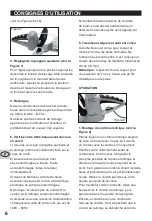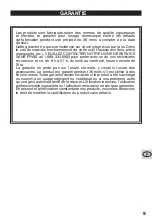
A
OPERATING INSTRUCTIONS
15
depressed in order to start the trimmer.
To switch the trimmer OFF, release either the
safety switch or the trigger switch.
Fig 10
3. Spirit Level (see Fig. 10)
A level is fitted on top of the hedge trimmer.
It is useful when trying to keep the blade
horizontal. When the bubble is in the center of
the level, then the trimmer will be horizontal.
4. Important Tips for Trimming Hedges
Assume a stable posture and hold the trimmer
with both hands. If using a step-ladder, make
sure it is securely located . If working on high
hedges, tie the ladder to the thicker inner
branches of the hedge for added support.
a – Ensure there are no by-standers or
animals in the work area
b – Always direct the power cable towards the
back of you, preferably over your shoulder.
Fig 11
Fig 12
Fig 13
5. Cutting Sequence
First trim the sides from the bottom upwards.
This prevents debris from falling into the area
which has yet to be cut (se Fig. 11). Try to
keep the blade angled at approximately 5º to
the work surface. This will improve the cutting
efficiency of the trimmer (see Fig. 12). Then
cut the top of the hedge. If the hedge is very
long, cut in stages rather than trying to cut the
entire length in at one time (see Fig. 13).
Fig 14
6. Shaping (see Fig. 14)
We recommend shaping the hedge into a
trapezoidal shape which is wider at the bottom
than the top. This will improve light penetration
resulting in a stronger hedge.
7. Optimal Trimming Times
Green leaf hedges are best trimmed between
June and October. Evergreens should be
trimmed in April and August, while conifers and
other fast growing shrubs can be trimmed every
6 to 8 weeks.
8. Older hedges
When older hedges need to be cut back
substantially, cut the thicker branches back






































